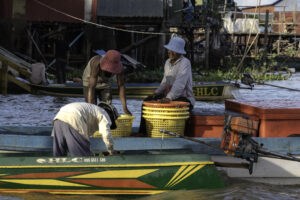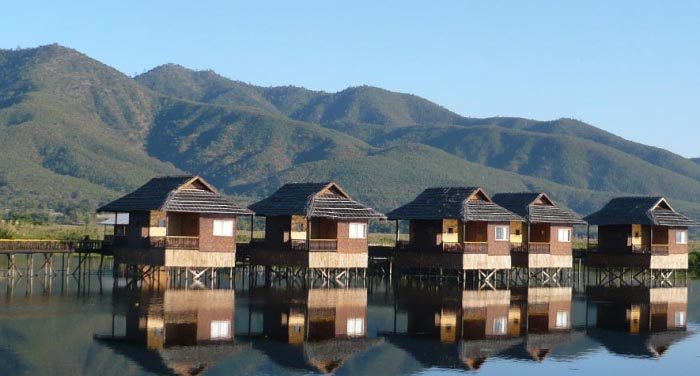
Inle Lake: A Glimpse into Life on the Water in Myanmar
By Rachael Rowe
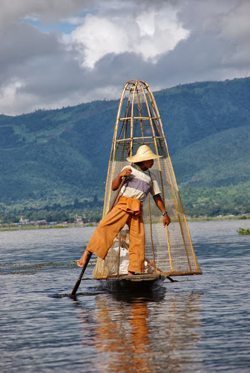
“These are acacia nuts. We use them to polish silver.” Suddenly the reason for so many yellow flowering acacia trees along the canals of Inle Lake in Myanmar made sense.
This was a traditional thriving community with interdependencies, and as I stood in the tiny but bustling silversmithing workshop those acacia nuts were being used to polish off the intricately worked bracelets and decorative baskets for sale.
There were so many questions to ask here about what things were and why things were done in a specific way when encountering a different way of life.
Inle Lake is a popular visitor destination in Myanmar and most people take a trip out to see the fishermen rowing with one leg. There is more to life here beyond the fishing boats, with 23 villages on floating islands and a myriad of cottage industries on stilted shacks.
Floating Gardens
A long-tailed boat sped past, covered with baskets of red tomatoes, heading for the markets. This is one of the largest salad-producing areas in Burma and the reason became clear when the pungent and aromatic scent of garlic and tomato plants filled the air.
These were the Floating Gardens of Inle Lake where rows of fruits and vegetables were being cultivated. Water hyacinth roots had been gathered as they clogged up the waterways.
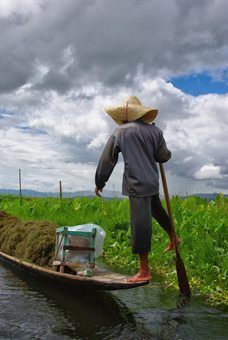
One innovative idea later and they were covered with silt and chicken manure to form some of the most fertile lands in the country, and now served as a collective farm for the local people. Watching the gardeners hoe land from boats was enchanting and a wonderful way to experience their community.
Cucumber, eggplant and tomato all made their way to local markets and towns bringing in much-needed income for the villages on the lake.
Fishing on Inle Lake
Out in the wider stretches of the lake, the fishermen were at work in the intense sunshine. Their unique method of rowing with one leg is famous but I found their conical nets fascinating to see as well.
The men know where the fish will be and position the basket-like cone in the water, agitating it to stun the fish, and then hooking them into a net. These are placed in baskets and transported live to tanks under the houses.
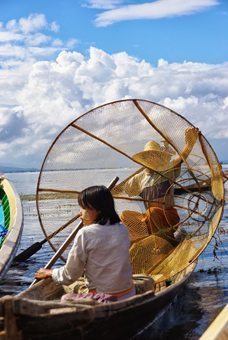
There is no refrigeration here and so any fish need to be kept as fresh as possible before eating. The small children on the boats were out learning all the tricks of the trade and eagerly watched as the nets were raised.
Silk Weaving and Blacksmithing
Tucked away in a cluster of stilt huts was a hive of activity. The clatter of weaving looms in a darkened room was almost medieval but the women were creating vibrant rainbow colors from the silk thread.
There was lotus silk weaving too. The threads come from the lotus plant and can only be harvested during the monsoon season, reflected in the higher price. One toothless old lady had been working at the loom for over 20 years and had the most beautiful weave displayed on her frame.
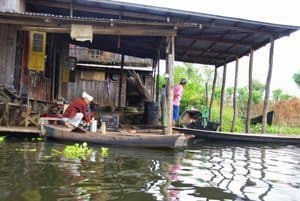
Just a few huts away the craftsmanship was very different. Stood around a roaring open fire were four men stripped to the waist, each hammering a piece of red hot metal in synchronization with each other.
Perched on the flue above the fire, a diminutive man manipulated huge bellows to keep the fire going and at the correct high temperature. For precision work, the heavy hammers managed to strike the right place every time.
Whilst it looked quite medieval and the working conditions would have had every health and safety inspector on edge in the West, here this was the way of life. Practical items from hooks to scythes were fashioned on those flames and in the unforgiving heat.
In another workshop, young girls sat cross-legged on the floor rolling cheroots. Their faces were smeared in thanaka paste which the Burmese use to protect their skin from the sun.
Above the door, a clear plastic bag filled with water was suspended from the ceiling. “It keeps flies away,” explained the older girl. There were no insect sprays here.
A few huts down the canal and two men could be seen bent over an outboard motor eagerly trying to fix it. This was clearly a garage Inle Lake style.
Village life and the markets
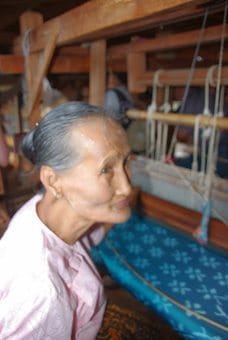
As the boat sped through the waters of Inle Lake the everyday life in the villages could be seen. Huge woven baskets were suspended from the shoulders of men and women as they walked along the paths toward the market.
Somewhere on Inle Lake, there is a market each weekday and it is quite a community event. The bright orange turbaned ladies had walked for three hours from the hill tribe areas to trade green tea for fish which they took back up to their villages.
There was a riot of color from the spice stalls where women looked for their cooking ingredients. A bony hand shot out and grabbed my wrist. With a toothless smile, the toffee seller offered me a taste of the peanut brittle, freshly made and delicious.
In a corner, a huge vat of noodle soup simmered away providing sustenance to traders and customers as a busy takeout café. Across the way from the steaming soup, I looked at a mysterious oily substance in what appeared to be recycled glass whiskey bottles.
“Gasoline,” came the response at my puzzled look. There were no gas stations here and so a lot of the fuel is sold by the side of the road, ready to be poured into engines.
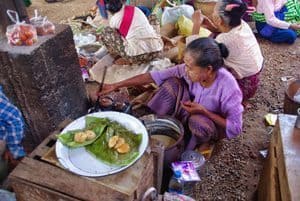
On the outskirts of the market, the thanaka paste lady used a whetstone to grind this famous bark and sold the pale yellowy cream to visitors eager to protect their skin from the relentless rays of the sun.
No Fishy Odor
Alongside the rows of fresh vegetables from the floating gardens and the new-laid eggs were salted fish. I could smell the freshness of the tomatoes but there was no odor with those fish, a sign of how fresh the food really was here. Red chilies were everywhere and their striking color contrasted with the vibrant hill tribe headdresses.
As my boat headed back through the lake canals the late afternoon saw more life in the stilt villages. From one house the smell of cooking dinner wafted across the water and children played amongst the boats, waving.
An old man sat by the water’s edge smoking a cheroot while sharpening a knife. The spirit and soul of Burma had enchanted me with its simplicity and hospitality. On Inle Lake seeing the small things so integral to daily life was what makes a journey so memorable.
Rachael Rowe is a freelance travel writer living in Dorset, England, and can be contacted via her website www.rachaelrowe.com
- The Wild Mississippi: 2340 Miles Across Ten States - April 8, 2024
- Exploring the Floating Villages of Tonle’ Sap Lake - April 3, 2024
- Woman Traveling Solo on Turkish Buses - March 27, 2024


